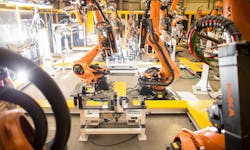System Integrator Reduces Commissioning with PC Control Platform
With ever-increasing electronics and networking, multiple types of drivetrains, material lightweighting and more to meet regulatory and market demands, an automotive renaissance is underway. Many carmakers are relying on automation upgrades to meet new challenges.
Portugal-based Sodecia designs automated assembly systems and increasingly uses PC-based control platforms to tackle the complexity of manufacturing in the automotive industry. With 32 manufacturing facilities around the world, the company makes manufacturing systems for chassis, powertrain and body-in-white (BIW) applications.
Sodecia relies on its Global Tech & Automation Centre (GTAC) in London, Ontario, to specify automation hardware, software and engineering support for the company’s manufacturing divisions. “Our current bread-and-butter product is our turnkey robotic weld cell solution,” says Brent Lekx-Toniolo, control system concept developer at Sodecia GTAC. “Each project is slightly different—based on unique application requirements—but the core machine technology remains the same.”
PC-based control in the driver’s seat
Since 2008, the Sodecia GTAC integration group has relied on PC-based control technology from Beckhoff Automation for its automotive projects.
“To date, Sodecia GTAC has built 49 manufacturing lines based on Beckhoff PC-based control, ranging anywhere from machines with a single robot to lines with over 20 articulated robots,” says Jon Bysma, controls specialist at Sodecia GTAC.
A recent automotive project—larger than any other undertaken by Sodecia GTAC—included 21 KUKA robots of various sizes, with payload capabilities of 6-210 kg (including the KR 210, KR 30 and KR 6 series). The BIW assembly line begins with an assortment of small stampings and subassemblies that are spot welded, arc welded (studs), stamped or sealed robotically. The finished subassemblies are automatically unloaded and transferred to subsequent stages. Multiple assemblies come together to form the bulk of the entire finished assembly.
At this point, the process splits into two identical product pipelines—creating redundancy and improving throughput. This section has left- and right-hand assemblies running down the same line, so the entire concept essentially has four pipelines.
The PC-based control system executes all sequencing for this assembly line, including fixture clamp/unclamp sequences, part detecting, error proofing, calling specific robots into fixtures, and necessary robot tasks. Sensors on set-down fixtures conduct comprehensive analysis and send data to the controller, ensuring that all fasteners are placed correctly on the assemblies. The controller also handles robot-to-robot interference detection, general production count and overall equipment effectiveness (OEE) tracking, while managing overall fault detection and annunciation by acting as the human-machine interface (HMI) for the machine.
Quick commissioning
This capital project began with Sodecia completing a floor layout for the cell and robot training, while PLC programming started at about the same time. KUKA controllers administer the motion control for each of the 21 robots in the assembly area, but the entire welding cell is coordinated by TwinCAT PLC software running on a 15-inch panel PC.
Sodecia used a range of software libraries to speed programming of the entire robot work cell, which includes 228 devices. “The software’s development environment and Sodecia’s modular code framework based on structured text reduces engineering time by a wide margin,” says Rob Remillard, lead controls engineer for Sodecia GTAC. Sodecia can develop sections of code in any of the IEC 61131-3 languages, prove them out, and then deploy instances of the code for evaluation.
EtherCAT networking handles all robotic communications, I/O and programmable safety functions via the safety I/O terminals. “With our modular machine design model, our safety configuration doesn’t change much,” Lekx-Toniolo says. “We simply remove sections we don’t need from the pre-built framework, but the underlying functionality remains the same.”
Each major automated component in the robotic assembly line is connected to a TwinSAFE logic terminal and a series of digital inputs and outputs to handle the processing of the safety I/O, as well as communication with other safety equipment. Safety functions include e-stops, machine monitoring, AND and OR functions, and decouplers.
Automakers are leaning on integrators to make capital improvements seamless. “Sodecia has cut control system commissioning time by at least 50 percent using PC-based control,” says Mark Mierkalns, plant manager for Sodecia GTAC.
Production is also hitting its stride. The carmaker for this particular project reports that the BIW assembly line achieves an average cycle time of just under 50 seconds, with 72 complex parts per hour and up to 355,000 parts per year.
About the Author
Grant Gerke
Digital Managing Editor

Leaders relevant to this article:
